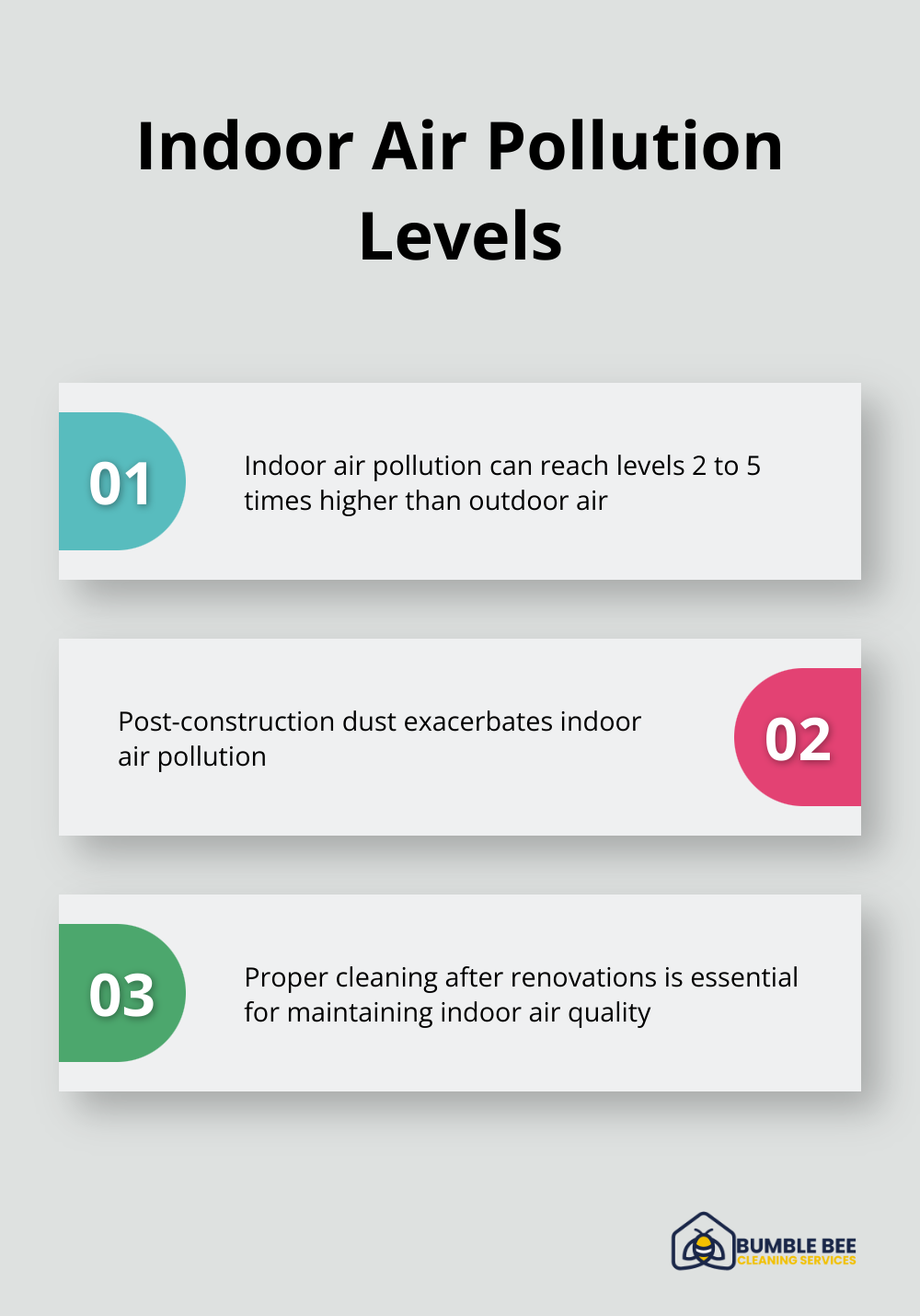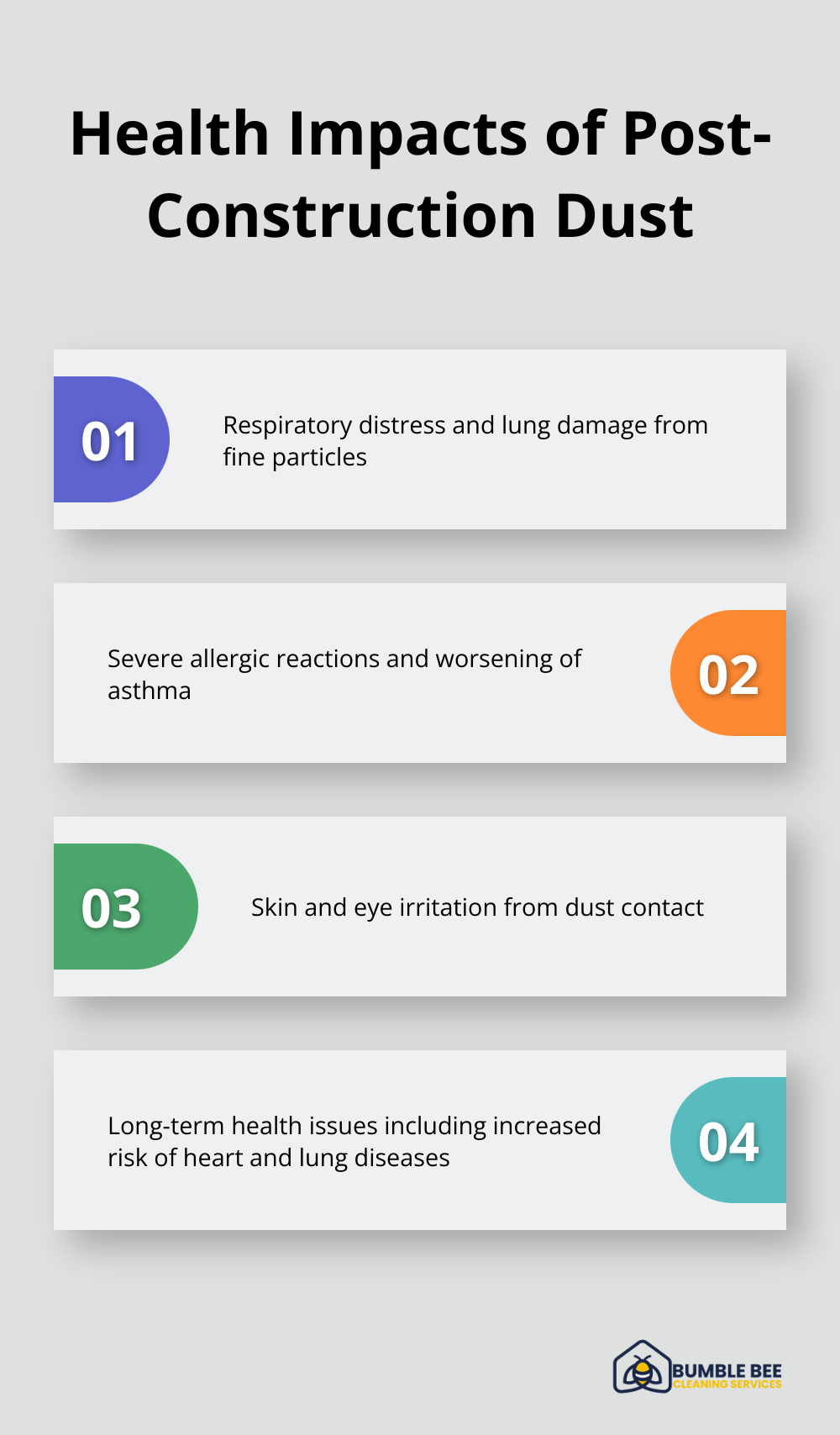Post-construction dust is a common issue in Seattle homes, often overlooked but potentially harmful to residents’ health. At Bumble Bee Cleaning Services, we’ve seen firsthand the impact this invisible threat can have on families and individuals.
From silica particles to chemical residues, the types of dust left behind after construction or renovation projects are diverse and concerning. In this post, we’ll explore the health risks associated with post-construction dust and provide effective methods for its removal, helping you maintain a safe and clean living environment.
What Dust Lurks After Construction in Seattle Homes?
Post-construction dust in Seattle homes poses more than just a nuisance; it presents a potential health hazard that demands serious attention. Various types of dust remain after construction projects, each carrying its own set of risks.
The Silent Threat of Silica Dust
Silica dust, produced when workers cut concrete or stone, ranks as one of the most dangerous types of construction dust. Employees exposed to respirable crystalline silica are at increased risk of developing serious adverse health effects including silicosis, lung cancer, and chronic respiratory diseases.
Wood Dust: More Than Just Sawdust
Wood dust from lumber and carpentry work constitutes another common post-construction contaminant. Western red cedar wood dust exposure is known to cause conjunctivitis, allergic rhinitis and/or occupational asthma.
The Pervasive Nature of Drywall Dust
Drywall dust, composed mainly of gypsum and silica, exhibits incredible fineness and remains airborne for days. The Environmental Protection Agency (EPA) warns that this dust irritates the eyes, skin, and respiratory system. Seattle’s damp climate exacerbates the problem, as the dust clings to surfaces and creates a breeding ground for mold.
Chemical Residues: The Invisible Danger
Paint particles and chemical residues left behind after construction present unique risks. Many paints and solvents contain volatile organic compounds (VOCs) that off-gas for weeks or even months after application. The American Lung Association links VOC exposure to headaches, nausea, and long-term organ damage.
Addressing these post-construction dust types requires more than a quick sweep. Professional cleaning services utilize specialized equipment like HEPA vacuums (which capture 99.97% of particles as small as 0.3 microns). This level of thoroughness proves essential for maintaining a healthy living environment after construction or renovation work.
As we move forward, let’s explore the specific health risks associated with these types of post-construction dust and understand why proper removal becomes so critical for Seattle homeowners.
How Post-Construction Dust Impacts Your Health
Post-construction dust presents significant health risks to Seattle residents. The Environmental Protection Agency (EPA) reports that indoor air pollution can reach levels two to five times higher than outdoor air, a problem that construction dust exacerbates. This invisible threat leads to a range of health issues, from minor irritations to severe long-term conditions.

Respiratory Distress and Lung Damage
Inhalation of post-construction dust causes immediate respiratory distress. Fine particles from materials like drywall and concrete penetrate deep into the lungs, resulting in inflammation and irritation. The Occupational Safety and Health Administration (OSHA) cautions that prolonged exposure to silica dust can result in serious silica-related diseases, including silicosis, a potentially fatal lung disease.
Seattle’s damp climate allows these particles to linger in the air for extended periods, which increases the risk of exposure. Many homeowners report persistent coughing, wheezing, and shortness of breath after renovation projects.
Allergies and Asthma Flare-Ups
Post-construction dust triggers severe allergic reactions and worsens existing respiratory conditions like asthma. The American Lung Association notes that construction dust often contains allergens such as mold spores, which thrive in Seattle’s humid environment. These allergens cause sneezing, runny nose, and in severe cases, asthma attacks.
Individuals with pre-existing respiratory conditions experience significantly worse symptoms due to the presence of construction dust. Many people with asthma report increased inhaler usage and more frequent doctor visits following home renovations.
Skin and Eye Irritation
Construction dust threatens not only when inhaled but also through external contact. Fine particles settle on skin and in eyes, which leads to itching, redness, and inflammation. Chemical residues from paints and solvents cause more severe reactions, including rashes and chemical burns.
The National Institute for Occupational Safety and Health (NIOSH) emphasizes the importance of proper protective equipment during and after construction to prevent these issues. However, many homeowners overlook this critical step (putting themselves at risk).
Long-Term Health Concerns
Prolonged exposure to post-construction dust results in serious long-term health issues. The EPA links chronic exposure to fine particulate matter to increased risk of premature death in people with heart or lung disease, nonfatal heart attacks, irregular heartbeat, aggravated asthma, and decreased lung function.
In Seattle’s unique climate, where dampness can trap pollutants indoors, the risk of long-term exposure increases. This situation underscores the need for thorough post-construction cleaning to mitigate these health risks.
The health impacts of post-construction dust extend far beyond temporary discomfort. From immediate respiratory issues to potential long-term diseases, the effects on your health prove significant and lasting. To address these risks effectively, we must explore proven methods for removing post-construction dust from Seattle homes.

How to Effectively Remove Post-Construction Dust
Post-construction dust removal requires a systematic approach and specialized equipment to ensure a thorough clean-up. The Environmental Protection Agency (EPA) emphasizes that proper cleaning after renovations is essential for maintaining indoor air quality. Here’s how to tackle this challenge effectively:
Professional Post-Construction Cleaning: A Wise Investment
Hiring a professional cleaning service for post-construction clean-up is often the most effective solution. These experts use industrial-grade equipment and follow strict protocols to remove even the finest particles. HEPA vacuums used by professionals efficiently capture harmful particles, preventing respiratory illnesses and long-term health issues among workers.
Professional cleaners also have the expertise to handle different surfaces without causing damage. They use specialized techniques for cleaning delicate materials like newly installed hardwood floors or freshly painted walls. This level of care prevents costly repairs or replacements down the line.
The Power of HEPA Filtration
HEPA (High-Efficiency Particulate Air) filtration systems play a key role in post-construction dust removal. These systems can be standalone units or integrated into vacuums and air purifiers. The National Institute for Occupational Safety and Health (NIOSH) recommends HEPA filters for their ability to trap ultra-fine particles, including those from drywall and concrete dust.

For optimal results, run HEPA air purifiers continuously for several days after the initial clean-up. This helps capture any remaining airborne particles and significantly improves indoor air quality.
Wet Cleaning: More Than Just Mopping
Wet cleaning techniques are essential for removing dust that has settled on surfaces. However, it’s not as simple as running a damp cloth over everything. Start with a thorough HEPA vacuuming to remove loose particles, then follow with wet cleaning using microfiber cloths and appropriate cleaning solutions.
For hard surfaces, use a damp microfiber mop with a pH-neutral cleaner to avoid damaging new finishes. On walls, a damp sponge or cloth works well, but be cautious with freshly painted surfaces. Always work from top to bottom to prevent recontamination of cleaned areas.
Proper Disposal of Construction Debris
Proper disposal of post-construction debris is important. Many materials can be recycled, reducing environmental impact. In Seattle, contractors must recycle or reuse at least 70% of waste generated on construction projects. Homeowners should follow similar guidelines, separating recyclable materials and disposing of hazardous waste according to local regulations.
When dealing with potentially hazardous materials like lead paint dust (common in homes built before 1978), it’s essential to hire certified professionals. The Seattle & King County Public Health department recommends professional cleaning services for homes with potential lead exposure to ensure safe removal and disposal.
Final Thoughts
Post-construction dust in Seattle homes poses significant health risks. From silica and wood dust to drywall particles and chemical residues, these contaminants can cause respiratory issues, allergic reactions, and long-term health problems. Seattle’s unique climate traps pollutants indoors, creating an environment where harmful particles linger.
Professional cleaning services mitigate these health hazards with specialized equipment like HEPA filtration systems. Experts remove even the finest particles that DIY methods often miss, improving indoor air quality and protecting newly installed surfaces. A professionally cleaned space promotes a healthier living environment and preserves the integrity of your newly renovated or constructed home.
Bumble Bee Cleaning Services uses eco-friendly products and advanced techniques to ensure your home is free from harmful dust and debris. Our team of professionals (certified in post-construction cleaning) strives to create a safer, cleaner, and healthier home environment in Seattle. Take a proactive step towards a dust-free home by contacting us today.
